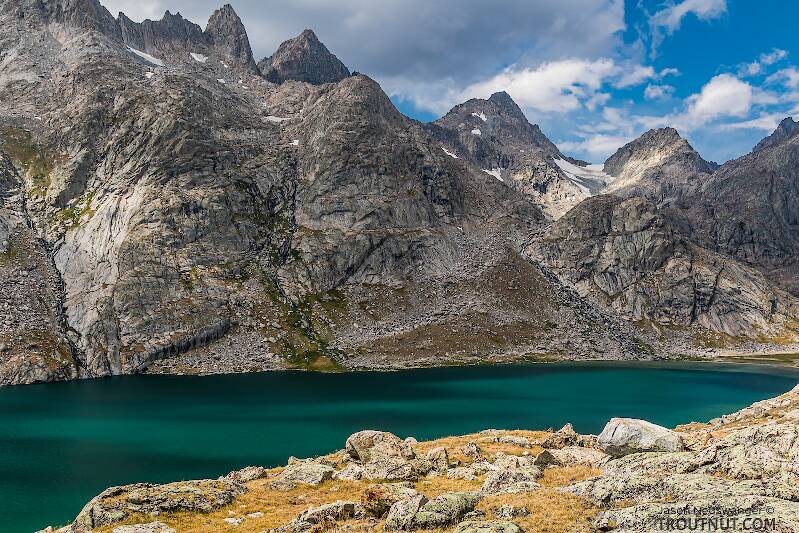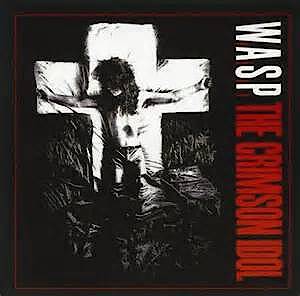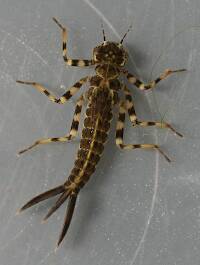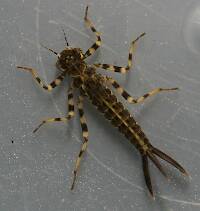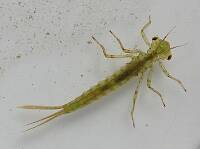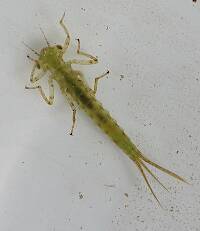
Salmonflies
Pteronarcys californica
The giant Salmonflies of the Western mountains are legendary for their proclivity to elicit consistent dry-fly action and ferocious strikes.
Featured on the forum

I was not fishing, but happened to be at an unrelated social event on a hill above this tiny creek (which I never even saw) when this stonefly flew by me. I assume it came from there. Some key characteristics are tricky to follow, but process of elimination ultimately led me to Sweltsa borealis. It is reassuringly similar to this specimen posted by Bob Newell years ago. It is also so strikingly similar to this nymph from the same river system that I'm comfortable identifying that nymph from this adult. I was especially pleased with the closeup photo of four mites parasitizing this one.

Troutnut is a project started in 2003 by salmonid ecologist Jason "Troutnut" Neuswanger to help anglers and
fly tyers unabashedly embrace the entomological side of the sport. Learn more about Troutnut or
support the project for an enhanced experience here.
Adirman on Apr 2, 2021April 2nd, 2021, 2:10 am EDT
I really like using the French coil as my sighter for distance nymphing. To me, there is very little difference between the coil (sometimes referred to as a "slinkie") and other floating indicators such as the "Thingamabobber" or yarn, for example; the only major difference being the coil often lies above the water's surface when in use. Of course, the coil-like any indicator used in nymphing- is only effective when it is highly visible--so, if your fishing your coil too far away from you, its basically useless!!
I'm still working on improving my formula and recipe; having said that, here is my latest output:
(User tried to post an image here without an source.)
This is my setup:
30lb Amnesia Chartreuse and Red Approx 18" each (I like the 30lb better than the 15lb simply because its "bigger" so, easier to see
Bloodknot pieces together
Perfection loop at each end
Wrap tightly around 2 1/2" Nail size 8D
Secure ends with cut rubber-band pieces to secure
Boil for 20 min thenfreeze overnight
Any comments/suggestions on improving would be great as I am FAR from being an expert here!!
Thanks,
NC Man
I'm still working on improving my formula and recipe; having said that, here is my latest output:
(User tried to post an image here without an source.)
This is my setup:
30lb Amnesia Chartreuse and Red Approx 18" each (I like the 30lb better than the 15lb simply because its "bigger" so, easier to see
Bloodknot pieces together
Perfection loop at each end
Wrap tightly around 2 1/2" Nail size 8D
Secure ends with cut rubber-band pieces to secure
Boil for 20 min thenfreeze overnight
Any comments/suggestions on improving would be great as I am FAR from being an expert here!!
Thanks,
NC Man
Martinlf on Apr 2, 2021April 2nd, 2021, 10:26 pm EDT
I tried the slinkies and didn't like them, but everyone has to find what works best for them. I prefer a straight sighter and yarn or an air lock bobber if I need more flotation. I'll grease my straight sighter and the bulk of a leader at times. My experience making the coils was like yours. The use of a bi-color coil makes sense. I used tippet rings instead of perfection loops, but I'd think either would work fine.
"He spread them a yard and a half. 'And every one that got away is this big.'"
--Fred Chappell
--Fred Chappell
Adirman on Apr 3, 2021April 3rd, 2021, 12:52 am EDT
I hear you and agree. What didnt you like about the slinkie? Ive always used it, ironically, for Czech nymphing although its mainly used on a longer tapered "French leader" . I find it to be very effective at fairly close ranges but further out, its efficacy diminishes because I have a hard time seeing it move if/when theres a take. Something I didnt know until yesterday was that according the original application of the French method, the slinkie is NOT supposed to to be in or on the water; rather, its supposed to be several inches to a foot (or more) ABOVE it!! I did not know that!! Ive always fished it resting on, or, slightly "in" the water.
At greater distances and/or deep water, I switch over to a Thingamabobber; never liked the yarn Indies much as they constantly get soaked and lose their bouyancy.
At greater distances and/or deep water, I switch over to a Thingamabobber; never liked the yarn Indies much as they constantly get soaked and lose their bouyancy.
Martinlf on Apr 6, 2021April 6th, 2021, 12:29 pm EDT
I'm not sure exactly what I didn't like. I think partly because of the slack it introduces. Many float the slinky; you'll find comp guys talking about that in places. I use the yarn indicator that Dom describes on the Troutbitten site. It floats high and dry when used as directed. But I know everyone has to find what works individually. I'm sure there are plenty of folks who can outfish me easily using a slinky.
"He spread them a yard and a half. 'And every one that got away is this big.'"
--Fred Chappell
--Fred Chappell
Adirman on Apr 7, 2021April 7th, 2021, 12:41 am EDT
Yes, I agree, "to each his own" as they say. Im sure that alot of our personal preferences are based on our conditioned fishing style aquired over time and experience. However, Im always looking for improvements; in regards to the slinkie, although effective, it does have its flaws-Id like it provide the visibility that a thingamobber does for me, especially at distance, for example. And the only way i can think of to achive that is to use thicker hi-vis colored line- but if its gets too think, I fear that it would diminish its strike detection efficacy.
Martinlf on Apr 8, 2021April 8th, 2021, 7:47 am EDT
I sometimes add a little dab or Orvis strike putty to my leader, either at the ends of the sighter, or elsewhere, to enhance visibility.
"He spread them a yard and a half. 'And every one that got away is this big.'"
--Fred Chappell
--Fred Chappell
Quick Reply
Related Discussions
Topic
Replies
Last Reply

